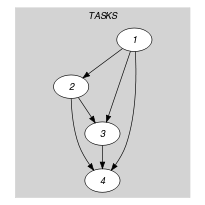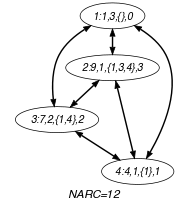5.122. disj
| DESCRIPTION | LINKS | GRAPH |
- Origin
- Constraint
- Argument
- Restrictions
- Purpose
All the tasks of the collection should not overlap. For a given task the attributes and respectively correspond to the set of tasks starting before task (assuming that the first task is labelled by 1) and to the position of task (assuming that the first task has position 0).
- Example
-
Figure 5.122.1 shows the tasks of the example. Since these tasks do not overlap the constraint holds.
Figure 5.122.1. Tasks corresponding to the Example slot

- Typical
- Symmetries
- Usage
The constraint was originally applied [MonetteDevilleDupont07] to solve the open-shop problem.
- Remark
This constraint is similar to the constraint. In addition to the and the attributes of a task , the constraint introduces a set variable that represents the set of tasks that end before the start of task as well as a domain variable that gives the absolute order of task in the resource. Since it assumes that the first task has position 0 we have that, for a given task , the number of elements of its attribute is equal to the value of its attribute.
- Algorithm
The main idea of the algorithm is to apply in a systematic way shaving on the attribute of a task. It is implemented in Gecode [Gecode06].
- See also
- Keywords
complexity: sequencing with release times and deadlines.
constraint arguments: constraint involving set variables.
constraint type: scheduling constraint, resource constraint, decomposition.
- Arc input(s)
- Arc generator
-
- Arc arity
- Arc constraint(s)
-
- Graph property(ies)
-
- Graph model
We generate a clique with a non-overlapping constraint between each pair of distinct tasks and state that the number of arcs of the final graph should be equal to the number of arcs of the initial graph. For two tasks and , the three conditions of the arc constraint respectively correspond to:
The fact that ends before the start of or that ends before the start of .
The equivalence between the fact that ends before the start of and the fact that the identifier of task belongs to the attribute of task .
The equivalence between the fact that ends before the start of and the fact that the attribute of task is strictly less than the attribute of task .
Parts (A) and (B) of Figure 5.122.2 respectively show the initial and final graph associated with the Example slot. The constraint holds since all the arcs of the initial graph belong to the final graph: all the non-overlapping constraints holds.
Figure 5.122.2. Initial and final graph of the constraint


(a) (b)